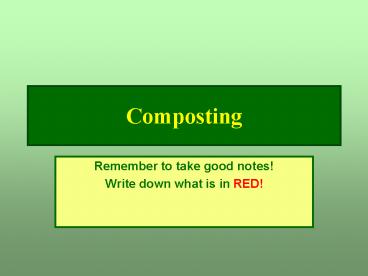Composting PowerPoint PPT Presentation
1 / 23
Title: Composting
1
Composting
- Remember to take good notes!
- Write down what is in RED!
2
Composting
Its Recycling
Naturally
3
What is composting?
Using the natural process of decay to change
organic wastes into a valuable humus-like
material called compost
Grass clippings
Food scraps
Leaves
4
Composting - Speeding up the natural decay process
- A compost pile or bin
- allows you to control
- Air (oxygen)
- Water
- Food, and
- Temperature
By managing these factors you can speed up the
otherwise slow natural decay process
5
Why compost yard and kitchen wastes?
- National Composting Council estimates the average
U.S. household generates 650 lb of compostables
every year.
6
What happens to your leftover food at lunch?
- Your food will ultimately be recycled by
decomposers and the matter will be transferred to
the soil.
7
- Limited landfill space should be reserved for
materials that cannot be recycled or composted - Garbage handling is the 4th largest expense for
many cities. Composting can reduce those costs - Near 35 waste in Texas is food.
8
What do you need to make compost?
- Decomposers simple organisms such as bacteria
or fungi that break down dead organisms and waste
and returns important nutrients to the
environment. Your composting work crew. These
are the microbes (mainly bacteria and fungi) that
do all the work for you. - Food for the decomposers The organic materials to
be composted - The right amount of air, water, and warmth to
keep the work crew happy
MOST of the energy in a compost bins is converted
into HEAT Energy!
9
Where do the decomposers come from?
If you build it, they will come
- Soil
- Leaves
- Food scraps
- Manure, and
- Finished compost
- Each of these will add microorganisms
- to the compost pile
10
One teaspoon of good garden soil added to compost
contains
- 100 million bacteria
- 800 feet of fungal threads
11
Numerous additives and starters are available but
are not needed for good or rapid composting
12
What is the best food for your decomposers?
All organic materials will compost, but not all
should be added to a backyard compost pile
Organic wastes that should be composted include
- Also
- Used potting soil
- Manure
- Sawdust
- Hair
13
Materials to avoid
- Avoid organic materials that could cause problems
during or after composting - Oil, fat, grease, meat, fish or dairy products,
unwashed egg shells (tend to attract pests,
vermin) - Hard to kill weeds (bindweed, quackgrass) and
weeds that have gone to seed (could infest garden
area when compost is used).
14
Is shredding necessary?
Have greater surface area per unit volume Allows
microbes to get at more of the food
Smaller particles decompose faster
Chipping or shredding coarse materials (twigs,
stems) will speed up the rate at which they
decompose
15
More about food for your decomposers
- Your compost workers will thrive if you give them
a balanced diet. - Composting will be most rapid if the decomposers
are fed a mix of carbon rich and nitrogen rich
materials. - Carbon rich organic wastes are known as browns
- Nitrogen rich organic wastes are known as greens
16
Browns
High carbon materials such as
Leaves Straw Paper Sawdust Animal bedding
mixed with manure (Manure provides food for
micro-organisms which enrich the soil)
17
Greens
High nitrogen materials such as
- Vegetable scraps
- Coffee grounds
- Grass clippings
- Manure-provides food for micro-organisms which
enrich the soil - Cow
- Horse
- Poultry
- Hog
18
- Browns
- Decay very slowly
- Coarse browns can keep pile aerated
- Tend to accumulate in the fall
- Tie up nitrogen in soil if not fully composted
- May need to stockpile until can mix with greens
- Greens
- Decay rapidly
- Poor aeration may have foul odors if composted
alone - Tend to accumulate in spring and summer
- Supply nitrogen for composting
- Best composting if mixed with browns
19
Why use a compost bin?Pile aerationGetting air
to your work force
- Turning the pile mixes fresh air into the pile
- Composting bins allows for biomass decay that can
be used as fertilizer
- Turning tools can make the job easier
20
Water
- Rapid decomposition requires optimum water
content - If too dry, bacterial activity will slow or cease
- If too wet, loss of air in the pile will lead to
anaerobic conditions
- Pile water content should be at 40-60
- As wet as a squeezed out sponge
- If too dry, add water as you turn the pile
- If too wet, add browns and/or turn the pile
21
When is compost finished?
- Compost is mature when
- The color is dark brown
- It is crumbly, loose,
- and humus-like
- It has an earthy smell
- It contains no readily
- recognizable feedstock
- The pile has shrunk to
- about 1/3 of its original volume
22
Bin/pile construction
- Ideal size is approximately a 3 foot cube
- Promotes sufficient aeration
- Retains sufficient heat to maintain warm temps
- Piles larger than 5 x 5 x 5 feet are difficult to
turn and tend to become anaerobic in the center
23
Benefits to Composting
- Reduce waste trash
- Increase oxygen in soil (it is richer but not a
fertilizer) - Biomass affects plants growth
- Biomass decays?decomposers feed on
biomass?decomposers return nutrients back to the
soil?Plants grow - Use of organic matter in soil
- Nutrients in humus

